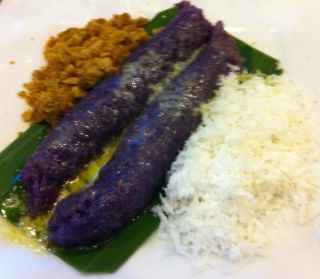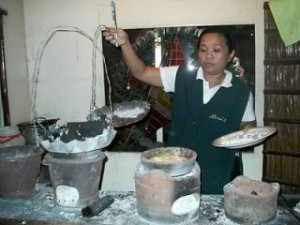by Ma. Rachel Roxas Yapchiongco
Many Filipinos have begun decorating their houses with Christmas lights, parols, and colorful trimmings. A lot of Christmas trees have been set up and decorated. Shops, restaurants, malls, and even streets are adorned with festive Christmas decorations. Young children enjoy going house to house early at night with their homemade musical instruments to sing Christmas carols. There is a slight chilly breeze and there’s that distinctive aroma in the air. Filipinos know this delicious smell too well. During Christmas season, nothing can be more enticing than freshly cooked puto bumbong and bibingka.
 Puto bumbong or bungbong is a long, thin, rectangular purple-colored sticky rice cake. It is named after the bamboo tube or bumbong used for steaming this type of puto. Its purple color comes from the violetpirurutong rice but in today’s modern times, violet food coloring is frequently used for convenience. The elongated shape of this sticky rice delicacy is produced by the steaming method using bamboo tubes. It is best served with freshly grated coconut, muscovado sugar or panutsa, and some butter or margarine.
Puto bumbong or bungbong is a long, thin, rectangular purple-colored sticky rice cake. It is named after the bamboo tube or bumbong used for steaming this type of puto. Its purple color comes from the violetpirurutong rice but in today’s modern times, violet food coloring is frequently used for convenience. The elongated shape of this sticky rice delicacy is produced by the steaming method using bamboo tubes. It is best served with freshly grated coconut, muscovado sugar or panutsa, and some butter or margarine.
Bibingka is a perfect partner for puto bumbong. It is made of galapong or rice flour, gata or coconut milk, sugar, eggs, and baking powder. The batter is poured into a small, round container lined with banana leaves and baked on live coals in a clay oven. It is usually topped with a slice of itlog na pula or salted duck egg, butter or margarine, freshly grated coconut, and sprinkled with some sugar.
Many Filipinos crave for these well-loved delicacies during Christmas season especially after attending the Simbang Gabi (9 dawn masses that start on December 16 and end on December 24).Enterprising Filipinos take advantage of this opportunity to make extra money during the holidays.
Aling Linda is one of those hardworking Filipinos who make the best out of every opportunity to provide a better life for the family. As soon as November sets in, she puts up her wooden stand in the same busy street corner to sellputo bumbong and bibingka. Aside from Aling Linda, four more others sell the same kakanin in the area. She doesn’t mind the competition because she knows that they all work hard to bring food to the table.
 Aling Linda has been making puto bumbong andbibingka for the past 12 years. She shared her time tested recipe with her two daughters and taught them the necessary skills to come up with the same quality of kakanin that her suki keep coming back to.
Aling Linda has been making puto bumbong andbibingka for the past 12 years. She shared her time tested recipe with her two daughters and taught them the necessary skills to come up with the same quality of kakanin that her suki keep coming back to.
If you’re thinking of putting up your own puto bumbong and bibingka stand, the first step is to find the right recipe that people will enjoy. There are manyputo bumbong and bibingka vendors but not everyone can make delicious holiday kakanin.
Before you start selling these Christmas delicacies, find several recipes that you like and try them at home. Invite family and friends for a taste test. Ask them to give you their honest opinions. List the comments down so you can review them later. Compare the opinions you’ve gathered and choose the recipe that the majority enjoyed the most.
Invest on basic cooking equipment such as langsungan and bamboo tubes for puto bumbong and circular baking pans and clay oven for bibingka. Buy fresh ingredients from the market. Find a good spot to put up your puto bumbong or bibingka stand. Choose a place with busy foot traffic to attract more customers. Coordinate with the local municipality to apply for business license or special food vendor permit.
Make your Christmas kakanin affordable to entice more customers. Nowadays, a typical bibingka sells for P25-P35 while puto bumbong sells for around P25.
How to make puto bungbong
Here’s a puto bungbong recipe based on EntrePinoys Atbp that you might want to try:
Ingredients:
- 1 kg galapong (glutinous) rice or malagkit, mixed with 125 grams ordinary rice
- 1/5 tsp. purple or violet food coloring
- Pandan leaves
- Salt
- 1 pc Shredded mature coconut
- Butter or margarine
- Banana leaves
- Water
- Sugar
Procedure:
- Prepare the glutinous rice. * When you buy malagkit/galapong at the market, have it grounded. Soak pre-ground glutinous rice and ordinary rice mixture in salted water together with purple or violet food coloring for 1 to 4 hours. Put the mixture inside a flour sack and let it dry overnight. Remove excess water by adding pressure using a hard object. * You can also choose to ground the mixture using a manual or stone grinder. Ground the mixture slowly and make sure that you do not add too much water in the process. Too much liquid will cause a delay in drying the milled ingredients. Excess water can make the mixture very sticky. Place milled ingredients into a cotton cloth and tie the corners and allow it to drip. When the mixture is almost dried, apply pressure on the cloth with a heavy object to squeeze out excess water. Let it stand overnight.
- Set aside the mixture. It is all set for cooking the following morning.
- Place pandan leaves in water to prepare it for steaming. Heat the special puto bumbong steamer, locally referred to as lansungan with just enough water. *The lansungan is a modified steamer with several holes on top (usually three) where bamboo tubes are placed for steaming. Tabora St. in Divisoria is a good place to buy puto bumbong steamer and bamboo inserts.
- Wrap the bamboo tubes called bumbong with cloth to protect the hands from getting burned. Put a small amount of galapong and rice mixture inside the bamboo tubes without packing it. Fill the tubes about 3/4?s full and steam for a few minutes until cooked. Remember to turn the tube over to finish cooking the other end of the puto bumbong.
- When it’s ready, carefully remove the tube from the steamer and firmly tap the end of the tube to extract theputo bumbong. This technique takes a little practice. You can also use skewer or knife to remove the puto bumbong.
- Serve it on a banana leaf or a plate with freshly grated coconut, muscovado sugar, and butter or margarine.
How to make bibingka
Watch this easy-to-follow video to learn how to make the traditional bibingka. Check out Panlasang Pinoy website for a complete and detailed recipe of bibingka.
Photos: “Bibingka” by Dennis Villegas c/o Wikipilipinas. Public domain; “Puto bumbong” by author.
Video: “Bibingka” c/o Youtube.
Originally posted at Philippine Online Chronicles